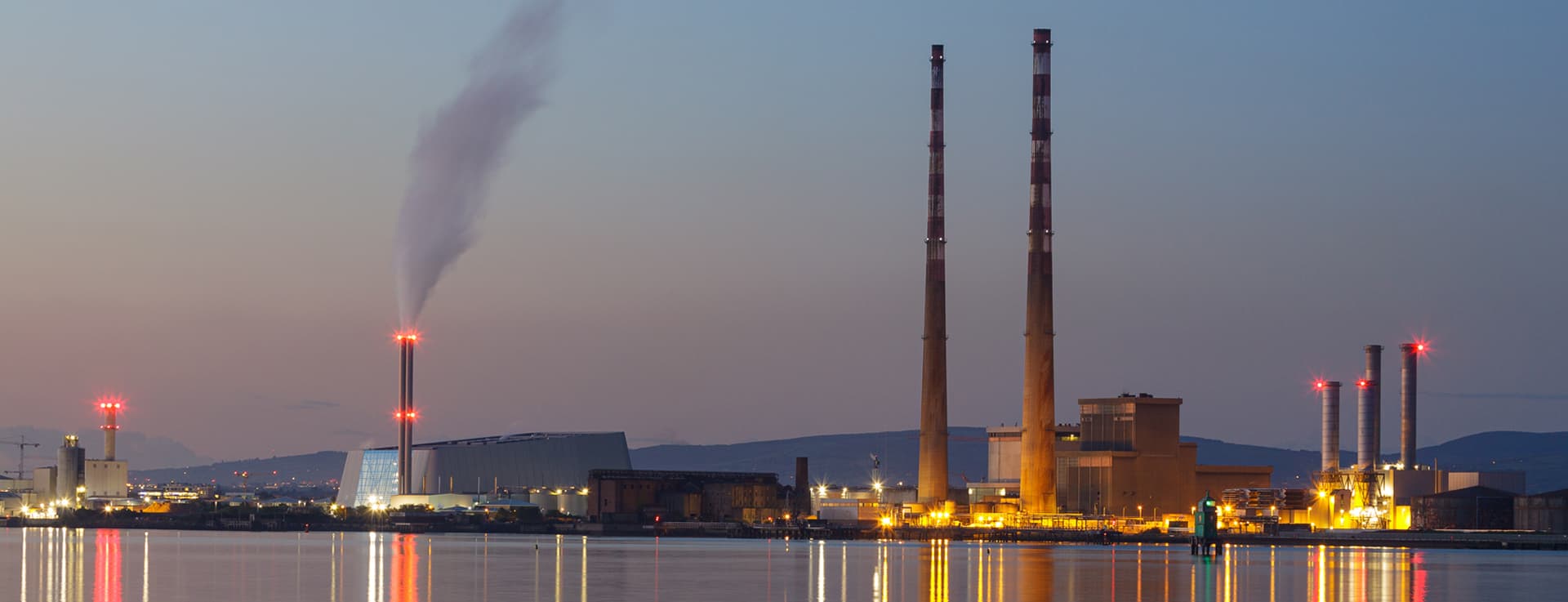
What a Difference a Day Can Make
The weekend of Saturday 9 / Sunday 10 of April 2022 was a fascinating one for the all-island electricity grid. This article provides some insights from VIOTAS as to what occurred.
Saturday
In the early hours of Saturday 9 April, a 400MW Combined Cycle Gas Turbine (CCGT) unit at Huntstown power station outside Dublin tripped and was unable to supply power to the grid. The Transmission System Operator, EirGrid, at 8am then issued a System Alert (Amber) Notification recognising a potential generation shortfall in Ireland. While the affected unit restarted at approx. 9:30am, it subsequently tripped again shortly thereafter.
System Alert notifications typically occur over the evening peak period during the winter months when system demand is at its highest, at c. 5,000 MW for Ireland. To see such an alert on a Saturday morning in April when the demand in Ireland was only 3,500 MW was a surprise to many, and is indicative of the evolving challenges in managing the power system as it transforms to accommodate progressively increasing renewable penetrations.
The unit trip at Huntstown coincided with very low wind generation due to a narrow ridge of high pressure sitting over Ireland. At the time of the System Alert notification, wind generation in Ireland stood at 149 MW and wasn’t expected to increase until later that evening. The average wind generation at 8am on the previous 8 days was in excess of 1,500 MW, more than 10x the amount of wind generation on Saturday morning.
Saturday’s events also coincided with a scheduled outage on the interconnector between Ireland and Great Britain (EWIC, 500 MW, scheduled outage until 3 May). This meant that, even with the Moyle interconnector importing 311 MW from Scotland into Northern Ireland on average over the course of the day, Ireland was only able to rely to a limited extent on power imports from its neighbours to provide support.
In addition, several large conventional generating units were on either scheduled or forced outage, including Great Island CCGT (461 MW), and Whitegate CCGT (444 MW) was unable to export due to a transmission fault.
EirGrid has also recently created a constraint preventing six Open Cycle Gas Turbine units in Ireland with a total capacity of approximately 300 MW from running for security of supply reasons unless the system is in, or close to, System Alert. While this will preserve run-hours on these units (which VIOTAS assumes have annual environmental limits) until the winter months if possible, in the interim it will increase the risk of System Alerts.
VIOTAS response:
VIOTAS and its customers rose to the occasion, providing 40 MW of demand response on Saturday morning after receiving dispatch instructions from EirGrid. Being able to call on this type of response at short notice is a critical tool relied upon by EirGrid to maintain grid stability even when conditions are at their most challenging.
Sunday
Having only met 2-3% of all-island system demand during most of Saturday, wind generation progressively increased over the course of Saturday evening and Sunday. From approximately 10:30am onwards on Sunday, wind generation never fell below 3,000 MW, peaking at in excess of 3,800 MW in the early evening.
As a result, wind generation met more than 75% of all-island system demand from 2:30pm onwards, rising to in excess of 80% from 8:30pm onwards as system demand started to decrease into the evening. Even with the Moyle interconnector exporting 385 MW on average over the course of the day from Northern Ireland to Scotland, the System Non-Synchronous Penetration (“SNSP”, a measure of the instantaneous penetration of non-synchronous generation technologies) was above 70% from 3pm onwards, and by the late evening was close to the binding system limit – recently increased to 75%.

As a result of high wind conditions due a blustery low pressure weather system passing over Ireland, EirGrid faced almost the polar opposite challenge on Sunday vs. the previous day: trying to manage a surplus of generation on the power system!
VIOTAS response:
During the course of most of Sunday, VIOTAS and its customers provided curtailment avoidance services to EirGrid, ramping back 24/7 on-site generation across a large number of sites, enabling EirGrid to accommodate the maximum amount of renewable generation onto the grid while staying within the power system’s operational limits. VIOTAS and its customers provided nearly 20 MW of such demand response, avoiding the curtailment of zero carbon renewable energy which would have otherwise been required.
Saturday vs. Sunday
As the trip on the affected Huntstown unit occurred on Saturday when wind generation was low, system demand was being met mainly by conventional generation units and system inertia was high. Therefore, while the trip caused a modest frequency disturbance due to high inertia (VIOTAS’ high speed systems recorded a system frequency nadir of 49.729Hz), low wind generation meant there were limited additional generation units available to be called on, driving the system into a System Alert status reflecting a potential capacity shortfall.

On Sunday, when the system was operating at close to its operational SNSP limit, the same unit trip would have likely resulted in a more significant frequency disturbance due to lower levels of inertia, drawing more deeply on the capabilities of fast response ancillary service providers such as battery storage assets and the advanced demand response capabilities provided by VIOTAS in partnership with some of its customers. However, due to the surplus of wind generation and more plentiful number of conventional units available in standby, the trip would be unlikely to have led to a risk of generation shortfall / System Alert.
The stark contrast between the conditions seen on the power system on Saturday vs. Sunday demonstrates how the challenges faced on the power system are progressively linked to wind conditions.
The week ahead
While Whitegate CCGT returned on Sunday 10 April as expected, many of the conditions identified above – in particular the coincidence of scheduled and forced outages on the EWIC interconnector and Great Island CCGT – will continue for the coming days. As a result, periods of low wind generation prior to the completion of these outages could lead to further periods of potential generation shortfalls in Ireland.
The system saw a further trip on another large conventional generation unit (Tynagh CCGT, 400 MW) in the early hours of Tuesday 12 April. With all-island wind generation less than 600 MW (and forecast to decrease further over the course of the day), this led EirGrid to issue a further System Alert (Amber) Notification, effective from 8am until 3pm on Tuesday 12 April due to a potential generation shortfall in Ireland. Several VIOTAS units were again called upon to support the grid on Tuesday morning, providing 38 MW of demand response.
At the time of writing VIOTAS understands the affected Tynagh CCGT unit was successfully returned to service at approximately 10am on Tuesday and continues to operate stably.
Conclusion
As we move to accommodate more renewables, given their inherently intermittent nature, we are likely to see these types of days / events becoming increasingly common. As such, the power system needs to become more flexible, and the type of flexibility offered by advanced demand response providers such as VIOTAS will become increasingly critical to maintaining grid stability and reliability.
VIOTAS would like to thank all its loyal customers for responding to the varied conditions seen on the power system over the past week, supporting the grid when we all needed it the most.
Ultimately, VIOTAS and its customers continue to play a crucial role in decarbonising the power system!
Published: Tuesday 12 April 2022, 17:00, written by Jon Sedgwick and Ayodele Bickersteth, VIOTAS Market Operations



